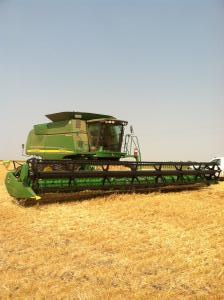Mark Seastrand, a barley farmer from North Dakota, officially finished his 2015 harvest at the end of August. Shortly after completion, Seastrand received reports back from the malters who purchased his barley on contract that they were pleased with both the quality and quantity of his crop.
On his farm, Seastrand also raises barley for seed production. In 2015, he planted a new variety, Genesis, developed by North Dakota State University.
“The Genesis barley turned out quite well,� Seastrand said. “It looked terrible because high winds and thunderstorms laid the plants on the ground a week prior to harvest, but it out-yielded my conventional six-row varieties.�
He plans to grow Genesis again next year for seed production. The growing process for conventional barley and barley intended for seed production is similar, but the North Dakota Seed Department must inspect the seed production fields at heading and do stand counts as part of a visual examination. After harvest, the grain must be cleaned and conditioned to undergo a certification process to ensure varietal purity, Seastrand said.
Seastrand said barley crop reports from across the state of North Dakota were good all around with most areas above average. However, a few areas detected Deoxynivalenol (DON or vomitoxin), a mycotoxin that may be produced by barley infected by Fusarium head blight, which is also known as scab.
In order to maintain a safe food supply, the U.S. Federal Grain Inspection Service (FGIS) and grain handling facilities collect samples when barley loads are delivered. The samples are measured for DON through laboratory procedures. DON is restricted to 1 parts per million (ppm) by the U.S. Food & Drug Administration (FDA) in all food-grade barley products.
The biggest challenge facing Seastrand’s crop is storage. Because of the length of his contract, he will have to use on-farm cold weather storage for upwards of nine months.
“When the harvested grain is at our farm, we have to monitor it closely for insects and moisture, so I am constantly climbing up and down our grain bins, probing and aerating to keep the grain cool and dry,� Seastrand said.
Planning is a constant process on Seastrand’s farm, as crop rotation is vital to his no-till farming operation.
“I’ve been evaluating this year’s soybean fields for crop residue and insect issues already, as they will be next year’s barley fields,� Seastrand said. “After the ground freezes later this fall, I will begin spreading fertilizer in preparation for 2016.�


